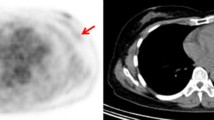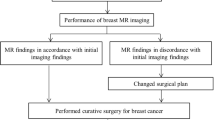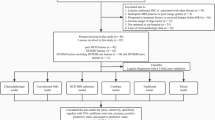Abstract
Purpose: This retrospective study was undertaken to investigate the morphologic and dynamic features of in situ and minimally invasive breast cancer on contrast-enhanced (c.-e.) MR imaging and to examine possible associations to pathology features. Material and methods: A total of 71 patients underwent MR imaging. T1-weighted FLASH-3D images were obtained before and after intravenous administration of Gd-DTPA. Histopathologic analysis of 78 lesions revealed ductal carcinoma in situ (DCIS)n=50 and DCIS with microinvasionn=28. MR features were correlated with histopathologic findings. Results: Enhancement in DCIS was focal (73%), diffuse (10%) or ductal (17%). No enhancement occurred in two cases (4%). In 65% enhancement speed was classified as delayed. There was a tendency toward a more ill-defined (83 vs. 43%) enhancement pattern in high grade DCIS and a more ductal (29 vs. 12%) and faster (50 vs. 29%) enhancement in comedo type DCIS. However, significant differences in the enhancement behaviour could neither be demonstrated between high grade and non high grade DCIS nor between comedo and non comedo type DCIS. No significant differences were noted between pure and microinvasive DCIS. Conclusion: In this retrospective analysis the majority (96%) of DCIS lesions show contrast enhancement. However, in only about 50% of DCIS the criteria of a so-called ‘typical’ enhancement behaviour was fulfilled, that means strong, early, focal ill-circumscribed or ductal. Enhancement that follows a duct is often associated with malignancy, however this feature was only present in 17% of the cases. c.-e. MR imaging allowed the detection of 25 additional foci of DCIS. Therefore malignant in situ lesions can be present with atypical enhancement, and should be taken into consideration in high-risk patients in particular.
Similar content being viewed by others
References
Goldsehmidt RA, Vietor TA. Lobular carcinoma in situ of the breast. Semin Surg Oncol 1996;12:314–20.
Carson W, Sanchez-Forgach E, Stomper P, Penetrante R, Tsangaris TN, Edge SB. Lobular carcinoma in situ: observation without surgery as an appropriate therapy. Ann Surg Oncol 1994;1(2):141–6.
Holland R, Peterse JL, Millis RR, et al. Ductal carcinoma in situ: a proposal for a new classification. Semin Diag Pathol 1994;11(3):167–80.
Silverstein MJ, Poller DN, Waisman JR, et al Prognostic classification of breast duct carcinoma-in-situ. Lancet 1995;345:1154–7.
Boyages J, Delaney G, Taylor R. Predictors of local recurrence after treatment of ductal carcinoma in situ: a meta-analysis. Cancer 1999;85(3):618–28.
Hetelekidis S, Collins L, Silver B, et al. Predictors of local recurrence following excision alone for ductal carcinoma in situ. Cancer85 1999;85(2):427–31.
Silverstein MJ, Lagios MD, Craig PH, et al. A prognostic index for ductal carcinoma in situ of the breast. Cancer 1996;77:2267–74.
Stomper PC, Margolin FR. Ductal carcinoma in situ: the mammographer’s perspective. Am J Roentgenol 1994;162:585–91.
Boetes C, Strijk SP, Holland R, Barentsz JO, van der Sluis RF, Ruijs JHJ. False negative MR imaging of malignant breast tumors. Eur Radiol 1997;7:1231–4.
Bone’ B, Aspelin P, Bronge L, Isberg B, Perbeck L, Veress B. Sensitivity and specificity of MR mammography with histopathological correlation in 250 breasts. Acta Radiol 1996;37:208–13.
Gilles R, Meunier M, Lucidarme O, et al. Clustered breast microcalcifications: evaluation by dynamic contrast-enhanced subtraction MRI. J Comput Assist Tomogr 1996;20(1):9–14.
Orel SG, Mendonca MH, Reynolds C, Schnall MD, Solin LJ, Sullivan DC. MR imaging of ductal carcinoma in situ. Radiology 1997;202:413–20.
Sittek H, Kessler M, Heuck AF, et al. Morphologie und anreicherungsverhalten des duktalen in-situ-karzinoms in der dynamischen MR-mammographie bei 1.0 T. Fortschr Röntgenstr 1997;167(3):247–51.
Soderstrom CE, Harms SE, Copit DS, et al. Three-dimensional RODEO breast MR imaging of lesions containing ductal carcinoma in situ. Radiology 1996;201:427–32.
Stomper PC, Herman S, Klippenstein DL, et al. Suspect breast lesions: findings at dynamic gadolinium-enhanced MR imaging correlated with mammographic and pathologic features. Radiology 1995;197:387–95.
Westerhof JP, Fischer U, Moritz JD, Ocstmann JW. MR imaging of mammographically detected clustered microcalcifications: is there any value? Radiology 1998;207:675–81.
Heywang-Köbrunner SH. Contrast enhanced magnetic resonance imaging of the breast. Invest Radiol 1994;29:94–104.
Heywang-Köbrunner SH, Schlegel A, Beck R, et al. Contrast-enhanced MRI of the breast after limited surgery and radiation therapy. J Comput Assist Tomogr 1993;17(6):891–900.
Fischer U, Westerhof JP, Brinck U, Korabiowska M, Schauer A, Grabbe E. Das duktale in-situ-karzinom in der dynamischen MR-mammographie bei 1.5 T. Fortschr Röntgenstr 1996;164:290–4.
Gilles R, Zafrani B, Guinebretiere J-M, et al. Ductal carcinoma in situ: MR imaging-histopathologie correlation. Radiology 1995;196(2):415–9.
Vaupel PW. Blood flow, oxygenation, tissue pH distribution and bioenergetic states of human breast cancer. Adv Med Btol 1997;411:243–54.
Author information
Authors and Affiliations
Rights and permissions
About this article
Cite this article
Viehweg, P., Lampe, D., Buchmann, J. et al. In situ and minimally invasive breast cancer: morphologic and kinetic features on contrast-enhanced MR imaging. MAGMA 11, 129–137 (2000). https://doi.org/10.1007/BF02678476
Received:
Revised:
Accepted:
Published:
Issue Date:
DOI: https://doi.org/10.1007/BF02678476




